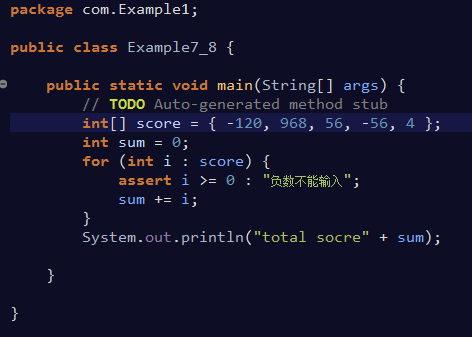1、内部类的外嵌类的成员变量在内部类中任然有效,内部类中的方法也可以调用外嵌类中的 方法,内部类中不可以声明类的变量和方法,外嵌的类体可以用内部类声明对象,作为外嵌类的成员。内部类仅供他的外嵌类使用。
package com.Example1;
public class Example7_1 {
public static void main(String[] args) {
// TODO Auto-generated method stub
RedCowForm form = new RedCowForm("jjf");
form.showMessage();
form.cow.speak();
}
}
class RedCowForm {
static String formName;
RedCow cow;
RedCowForm() {
}
RedCowForm(String s) {
cow = new RedCow(12, 12, 12);
formName = s;
}
public void showMessage() {
cow.speak();
}
class RedCow {
String cowName = "Red";
int height, weight, price;
RedCow(int h, int w, int p) {
this.height = h;
this.weight = w;
this.price = p;
}
void speak() {
System.out.println("****" + cowName + "###" + height + "###" + formName + "" + weight);
}
}
}
2、匿名类的概念
匿名类可以继承父类的方法也可以重写父类的方法,使用匿名可以直接用匿名类创建对象,因此匿名类一定是内部类,匿名类可以访问外嵌类中的成变量和方法,匿名类体重不可以声明static成员变量和static方法。由于匿名类是一个子类,没有类名,匿名类创建对象的时候要直直接使用父类的构造方法。
package com.Example1;
public class Example7_3 {
public static void main(String[] args) {
// TODO Auto-generated method stub
ShowBoad board = new ShowBoad();
board.showMessage(new outputEnglish());
board.showMessage(new OutputAlphabet() {
public void output() {
for (char c = 'a'; c < 'w'; c++)
System.out.printf("%3c", c);
}
});
}
}
abstract class OutputAlphabet {
public abstract void output();
}
class outputEnglish extends OutputAlphabet {
@Override
public void output() {
for (char c = 'a'; c < 'z'; c++) {
System.out.printf("%3c", c);
}
}
}
class ShowBoad {
void showMessage(OutputAlphabet show) {
show.output();
}
}
4、和接口有关的匿名类
package com.Example1;
interface SpeakHelloMan {
void speak();
}
class HelloMeachine {
public void turnOn(SpeakHelloMan hello) {
hello.speak();
}
}
public class Example7_7 {
public static void main(String[] args) {
// TODO Auto-generated method stub
HelloMeachine machine = new HelloMeachine();
machine.turnOn(new SpeakHelloMan() {
public void speak() {
System.out.println("hello you are welcome");
}
});
machine.turnOn(new SpeakHelloMan() {
public void speak() {
System.out.println("欢迎光临");
}
});
}
}
5、异常类的概念
异常类处理会改变程序的控制流程,让程序有机对错误做出处理,java使用throw关键字抛出一个Exception子类的实例表示异常发生。使用try -catch语句操作异常语句
package com.Example1;
public class Example7_4 {
public static void main(String[] args) {
// TODO Auto-generated method stub
int n = 0, m = 0, t = 100;
try {
m = Integer.parseInt("232342");
n = Integer.parseInt("787676");
t = Integer.parseInt("2402321");
} catch (NumberFormatException e) {
System.out.println("发生异常" + e.getMessage());
}
System.out.println(m + " " + n + " " + t);
try {
System.out.println("抛出异常");
throw new java.io.IOException("异常");
} catch (java.io.IOException e) {
System.out.println("eccor error" + e.getMessage());
}
}
}
6、自定义异常类的概念
在写程序的时候可以扩展Exception类定义自己的异常类,一个方法在声明的同时可以使用关键字throw抛出干个异常,并在方法的方法体中给出异常的操作,即用响应的异常类创建对象,并使用throw关键字抛出异常的对象,导致该异常结束。
package com.Example1;
public class Example7_5 {
public static void main(String[] args) {
// TODO Auto-generated method stub
Bank bank = new Bank();
try {
bank.income(200, -22);
bank.income(452, -222);
bank.income(200, -600);
System.out.println(bank.getMoney());
bank.income(9999, -666);
} catch (BankException e) {
System.out.println("出现问题");
System.out.println(e.warnMess());
}
}
}
class BankException extends Exception {
String message;
public BankException(int m, int n) {
message = "in" + m + "out" + n;
}
public String warnMess() {
return message;
}
}
class Bank {
private int money;
public void income(int in, int out) throws BankException {
if (in <= 0 || out >= 0 || in + out <= 0) {
throw new BankException(in, out);
}
int netIncome = in + out;
System.out.println(" " + netIncome);
}
public int getMoney() {
return money;
}
}
7、断言处理概念
断言语句:程序不准备通过捕获异常来处理错误,直接暂停。 assert BooleanException:message
